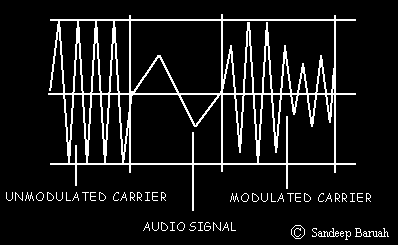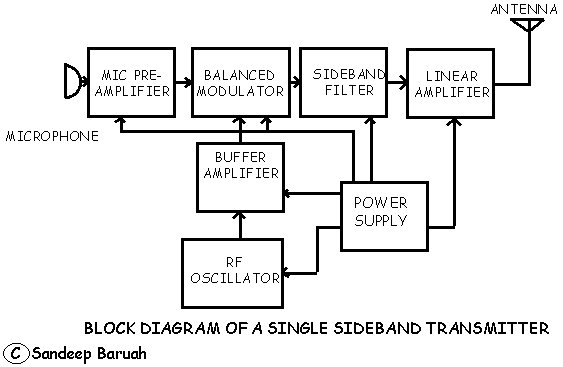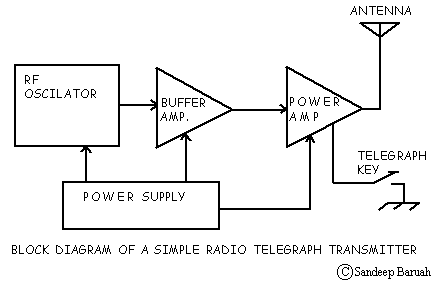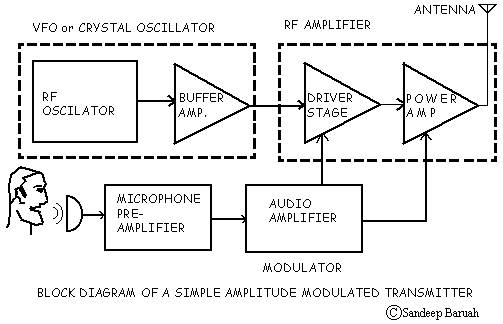TRANSMITTERS
What is
Amplitude Modulation and % ge of modulation?
Why
over modulation is not desirable?
What
are the Side-bands?
What
is Single Side Band (SSB) transmission?
Why
100% modulation should be aimed in voice transmission?
Draw
the schematic diagram of your intended transmitter and explain its function in brief.
Draw
the block diagram of a simple CW (Morse) Transmitter.
Draw
the block diagram of an Amplitude Modulated transmitter.
What is Amplitude Modulation and % ge of modulation?.
Amplitude Modulation (AM) is a process in which the amplitude of a radio frequency current is made to vary and modify by impressing an audio frequency current on it.

A radio frequency current has a constant amplitude in absence of modulation and this
constant amplitude RF carries no information, i.e. no audio intelligence and is of no use
to radio telephone (voice communication), but has application in morse code communication.
So, to give intelligence to the RF current, audio signal is impressed/superimposed on the RF current in a non-linear modulator circuit; as a result of which carrier current amplitude begins to rise to a maximum value above and below its original amplitude during the positive cycle of the audio signal and during the negative cycle of the audio signal, it falls to a minimum value.
This results in the carrier having two outlines of the audio signal, this is because the variation at instant in the amplitude of the carrier wave is directly proportional to the value of the modulating signal.
During amplitude modulation, two side band frequencies are also produced. Upper sideband frequencies equal to the carrier frequency plus audio frequency and lower side band frequency is equal to carrier frequency minus audio frequency. So the amplitude modulated carrier occupies a space in frequency spectrum, the width of which is equal to twice the highest modulating frequency.
Persentage of modulation:
The degree of modulation in an AM wave is expressed by %ge of maximum deviation from the normal amplitude of the carrier RF wave.
The effect of such modulated wave is measured by a receiver's ability to reproduce the signal in distorted or undistorted manner.
Percentage of modulation=(VoltageMax-VoltageMin)/(VoltageMax+VoltageMin) x 100
Where VoltageMax is the maximum
instantaneous value of the modulation and VoltageMin is the minimum value of
the RF carrier.
Why over modulation is not desirable?..
Over modulation is not desirable, i.e. modulation should not exceed 100 %, because if modulation exceeds 100 % there is an interval during the audio cycle when the RF carrier is removed completely from the air thus producing distortion in the transmission.
What are the Side-bands?...
Side bands are the sum and difference frequencies produced at the transmitter by the modulating frequencies. For instance a 5 kHz (5,000 Hz) Audio tone might be used to modulate an 800 kHz carrier frequency. This would produce frequencies of 800 kHz, 805 kHz and 795 kHz
What is Single Side Band (SSB) transmission?....
At full modulation the carrier in an AM signal requires two thirds of the power but conveys no information. The second side band can be viewed as rebundant (overlooking frequency-selective fading in an ionospheric transmission path, that may distort one side band at times). Interference between several carrier frequencies, resulting in steady audio whistles or 'beats' is another disadvantage of AM.
Power may be saved and the band occupied by an AM signal in the frequency spectrum can be halved if only one side band is transmitted without carrier. The result is single side band suppressed carrier signal, called simply single side band signal (SSB) transmission.
The carrier must be reintroduced at the receiver in such systems and closely adjusted to the original carrier frequency to avoid signal distortion. The introduced carrier carrier must be within 10 or 20 Hertz of the original carrier frequency for adequate intelligibility of voice signals, and stable oscillators are needed for generation of the local carrier.
For SSB the transmitter does not need
to generate carrier power, and ratings are in terms of peak-envelope-power (PEP), the
power capability at the peak of the modulating signal with linearity of the amplifier is
maintained. For equal information content, and 100% modulation, the SSB signal requires
only 1/6 th power of the double side band signal. However, the
situation is even more favourable to SSB when speech is transmitted. Speech is not a
continuous sine wave, and its average power is low with respect to its peak requirements.
A peak-to-average power ratio of 10:1 is often assumed for speech, and under that
condition, a Double Side Band (DSB) AM signal would require 1.05 times carrier power,
whereas for equal intelligibility the SSB signal would require only 0.05 units of power or
1/21 as much.
Because of the lower power rating, circuit components designed for SSB equipment can be
smaller and lower in cost.
For generation of a modulated signal without carrier, a balanced modulator is used. A
filter then discards one side band.
Why 100% modulation should be aimed in voice transmission?.....
The power of a modulated wave is found from the formula:
Pmod=(1+m2/2) x Pcarr
Where Pmod=Power of the modulated wave,
M=degree of modulation,
Pcarr=power in the carrier frequency.
The power in an amplitude modulated wave is divided between the carrier and the two side bands. The carrier power is constant, and so, the side band power is the difference between the carrier power and the total power in the modulated wave. The above formula is to find the power of the modulated wave when carrier is modulated by single sinusoidal tone.
If the carrier power=50 watts
%ge of modulation=100 or 1
degree of modulation=1
Then the power of the modulated wave,
Pmod=(1+m2/2) x 50=3/2 x 50 = 75 watts
Since the carrier power = 50 watts; the two side bands have 25 watts in them, i.e.
25
/75 x 100% = 33.3% of the total power with 100% modulation.In case of 50% modulation with same carrier power we have,
Pmod=(1+0.52/2) x 50 = 2.25/2 x 50 = 56.25 watts
Now the side bands have only 6.25 watts (since 56.25-50 = 6.25)
Since all the intelligence being transmitted is contained in the side bands, the desirability of a high percentage of modulation is crystal clear. A comparatively low powered, but well modulated transmitter often produces a stronger signal at a given point than does a much higher powered, but poorly modulated, transmitted the same distance from the receiver.
Draw the schematic diagram of your intended transmitter and explain its function in brief.......
 |
RF Oscillator
This is the stage where the carrier frequency intended to be used is generated by means of Crystal Oscillator Circuitry or capacitance-inductance based Variable Frequency Oscillator (VFO). The RF oscillator is designed to have frequency stability and power delivered from it is of little importance, hence can be operated with low voltage power supply with little dissipation of heat.
Buffer Amplifier
The low power RF carrier output from the RF oscillator is amplified in this portion and it also keeps the RF oscillator and power amplifier circuits separate electrically imparting frequency as desired by the amateur can be done in this stage, when the carrier frequency multiplication technique is applied here. In it the Morse key for keying out carrier continuous wave can be accomodated.
Modulator
Audio information is impressed upon the carrier
frequency at this stage
Balanced Modulator
In this type of modulator, while the audio information (voice) is impressed upon the carrier frequency, at the same time its output gives a signal without carrier frequency but yet with the two side band frequencies carrying the voice/audio information.
Side-band filter
It discards out any one of the side band.
RF linear Amplifier
RF power amplification is done here and
this stage is coupled to the antenna system through antenna impedance matching circuitry.
Care is taken at this stage so that no harmonic frequency is generated which will cause
interference in adjacent band (splatter) on other bands.
Draw the block diagram a simple CW (Morse) Transmitter........
 |
Draw the block diagram of an Amplitude Modulated transmitter.........
 |
Page maintained by Ex-VU2MSY (now VU2MUE)